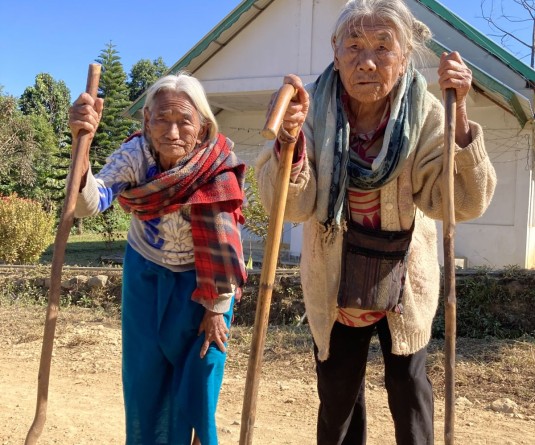
Samuel
Padumpukhuri, Dimapur
Nagaland, a vibrant state in northeastern part of India, is known for its diverse tribal cultures, stunning landscapes, and rich cultural history. However, despite its uniqueness, the state faces significant challenges when it comes to the inclusion and acceptance of Children with Special Needs (CWSN). Like much of the country, Nagaland grapples with issues of stigma, limited infrastructure, and insufficient resources for CWSN. Yet, despite these challenges, a growing movement within the state is working to build bridges—bridges of understanding, access, and opportunity—for children with special needs. This journey toward acceptance is not just about changing policies and systems, but about transforming attitudes, promoting inclusivity, and ensuring that CWSN are seen as equal members of society. As the world observes International Day of Persons with Disabilities (IDPD) today which is also known as World Disability Day to raise awareness about the challenges faced by individuals with disabilities and to promote their rights, dignity, and inclusion in society. It serves as a reminder that people with disabilities deserve equal opportunities in all areas of life, from education and employment to healthcare and public spaces. Let us look at the scenario of our present day challenges faced by the CWSN in Nagaland and the need for acceptance.
1. Overcoming Stigma: Changing Mindsets and Raising Awareness
One of the most significant barriers CWSN face in Nagaland is social stigma. In many communities, children with disabilities are often misunderstood, marginalized, or even hidden from view due to traditional beliefs or a lack of awareness about different types of disabilities. Disability is frequently associated with shame, and in some cases, the presence of a child with special needs may be seen as a family’s burden and is considered as a curse/punishment from God for our past mistakes/sins rather than an opportunity for growth and inclusion.
The journey toward acceptance begins with “changing mindsets”. Raising awareness about disabilities, their causes, and the potential for individuals with special needs to lead fulfilling lives is the key to eliminating stigma. Awareness campaigns that educate the public, particularly in rural areas, are essential in shifting cultural perceptions. These efforts can be carried out through:
(a)Community-based Awareness Programs: Workshops, seminars, and outreach programs in schools, villages, and local communities can provide valuable education on different disabilities and promote understanding. Highlighting success stories of individuals with special needs who have excelled in education, arts, sports, or other fields can inspire both families and communities to view CWSN with pride rather than pity.
(b) Media and Social Media Campaigns: Various print media like Newspapers, Pamphlets and visual media like local news channels and Social media platforms like Facebook, Instagram and YouTube can amplify the message of inclusion and change public perceptions. In a state like Nagaland, where social media plays an important role in daily life, campaigns that reach wider audiences can challenge myths and misconceptions about disability.
(c) Involving Community Leaders: In Nagaland, where the tribal and community system is deeply influential, the involvement of local leaders and elders is crucial. When respected figures within the community speak out in favor of inclusion, it can significantly reduce stigma and encourage other community members to follow suit.
(d) Local churches, which are central to life in many Naga communities, are also expected to play a crucial role in advocating for the acceptance of CWSN. Through their networks, churches can organize more awareness campaigns and support groups for parents and caregivers.
(e) NGO Involvement and Community-Based Initiatives: Several non-governmental organizations (NGOs) in Nagaland are playing a key role in raising awareness, providing training to teachers, and offering support to families. These organizations work to promote social inclusion and ensure that children with special needs receive adequate education and healthcare.
2. Inclusive Education: Providing Equal Opportunities
The foundation for greater acceptance of CWSN in Nagaland lies in inclusive education. Education is a powerful tool for breaking down barriers and fostering understanding among children from an early age. However, for CWSN, accessing quality education often requires overcoming significant challenges:
(a) Lack of Resources and Trained Teachers: Many schools in Nagaland lack adequate resources to support CWSN. Teachers often do not have the training or tools to work with children who have physical, intellectual, or developmental disabilities. Moreover, most of the schools in Nagaland do not have the physical infrastructure to accommodate children with mobility impairments (e.g., ramps, accessible restrooms, etc.).
(b) Limited Specialized Support: Special education programs and therapies such as speech therapy, occupational therapy, or physiotherapy are not widely available. In fact it is very limited. There are hardly any specialized services available even in Dimapur and Kohima which is considered as the hub of Nagaland. For children with conditions like autism, cerebral palsy, or intellectual disabilities, these services are crucial to their development and integration into society.
To address these barriers, several steps can be taken:
(a) Training and Sensitization for Teachers: Teachers in Nagaland need training on special education and inclusive teaching methods. This includes equipping educators with the knowledge and skills to adapt lessons for children with different abilities, use assistive technology, and provide emotional support. Specialized teacher training programs should be developed and implemented in collaboration with educational institutions and NGOs focused on disability.
(b) Physical Accessibility and Infrastructure: The government should prioritize making schools physically accessible to CWSN. Simple modifications, like building ramps, ensuring classrooms and toilets are wheelchair-friendly, and providing appropriate seating arrangements, can make a world of difference. Additionally, schools should invest in specialized learning materials such as Braille books, audio aids, and digital resources that cater to children with visual or hearing impairments.
(c) Promote Special Education Schools and Inclusive Classrooms: Nagaland can invest in establishing special education schools in key districts, especially in areas that are currently underserved. Simultaneously, mainstream schools must adopt inclusive teaching practices that allow children with disabilities to study alongside their peers. By doing so, children with disabilities gain social interaction and develop important skills for life, while other students learn empathy, cooperation, and acceptance.
(d) Peer Mentorship and Awareness Programs: To foster a deeper sense of understanding and inclusion, schools should implement peer mentorship programs, where children with special needs are paired with neurotypical peers. This not only encourages friendship but also helps break down stereotypes about disability. Peer-led workshops and interactive sessions can also be held to teach children about disabilities, fostering acceptance at an early age.
3. Healthcare Access: Ensuring Early Intervention and Specialized Support
For children with special needs, early intervention is essential for improving developmental outcomes. However, healthcare services in Nagaland, even in urban areas like Dimapur and Kohima is still limited in terms of accessibility, resources, and trained personnel. Children with disabilities often face long waiting times for medical diagnoses, therapy, and follow-up care. Health services and specialized therapies (such as speech therapy, occupational therapy, or physiotherapy) are often limited in Nagaland. Families must travel long distances to access these services, which may be unaffordable or impractical, especially for economically disadvantaged households.
To bridge this gap, Nagaland must focus on:
(a) Improving Access to Diagnostic Services: The state should increase the availability of pediatric specialists, such as pediatricians trained in developmental disabilities, speech therapists, and occupational therapists. Establishing early diagnosis centers in both urban and rural areas would ensure that children are diagnosed early, which is critical for accessing therapy and support at the right time.
(b) Training Healthcare Providers: Healthcare professionals in Nagaland must receive specialized training to diagnose and treat children with disabilities. Government-run medical institutions and hospitals can partner with national medical institutes and NGOs to improve local healthcare providers' capacity to manage special needs cases.
(c) Government Support for Families: Medical care and therapies for CWSN can be financially burdensome for many families in Nagaland. The government should introduce financial support mechanisms, such as subsidies, insurance schemes, and free or low-cost access to medical treatment and therapy. Providing families with financial aid can reduce the economic strain and ensure that children have access to the services they need.
4. Social Integration: Creating a Culture of Acceptance
Beyond education and healthcare, the social integration of CWSN is crucial for their overall well-being and acceptance in society. In Nagaland, traditional attitudes towards disability often lead to social exclusion. CWSN may be isolated from community events, sports, festivals, or even from participating in family gatherings.
To ensure social acceptance, it is important to:
(a) Encourage Inclusive Community Activities: Public events, sports competitions, festivals, and other community gatherings must be made accessible to CWSN. This includes ensuring physical accessibility (e.g., wheelchair ramps, designated seating) and creating an inclusive environment where children with disabilities can participate fully. Communities should celebrate diversity and organize events that showcase the talents of children with disabilities.
(b) Promote Disability Awareness in Local Media: Media campaigns can help spread positive messages about CWSN and highlight their contributions to society. Stories of successful CWSN can inspire other families and communities to view disability not as a limitation but as an opportunity to embrace difference.
(c) Support for Families and Caregivers: Raising a child with special needs can be challenging, and families often face emotional and financial stress. Support groups and community networks can provide a safe space for parents and caregivers to share their experiences, seek advice, and find emotional support. NGOs and community leaders can also offer counseling services to help families navigate the challenges of raising children with disabilities.
5. Government and Policy: Ensuring Stronger Support Systems
While the efforts of individuals and local communities are important, the government has a central role to play in fostering an inclusive society for CWSN. Policies must be enacted and properly implemented to ensure that children with disabilities receive the support they deserve.
Key steps include:
(a) Enforcing Disability Rights Legislation: The Indian government has passed the Rights of Persons with Disabilities Act (RPWD Act), which mandates that children with disabilities have the right to education, healthcare, and equal opportunities. The Nagaland government must ensure that these provisions are strictly followed, particularly in rural areas, and that resources are allocated for disability-specific services.
(b) Coordinating with NGOs: NGOs and civil society organizations have been at the forefront of advocating for CWSN and providing on-the-ground support. The state government should collaborate with these organizations to extend the reach of programs and services to rural and underserved areas.
(c) Building Disability-Friendly Infrastructure: Infrastructure development in the state must prioritize accessibility. This includes making government offices, schools, hospitals, public transport, and other public spaces disability-friendly.
(d) An increase in the amount of scholarship for the CWSN. At present the CWSN receives a meager amount of scholarship from the Government through the Department of Social Welfare for classes 1 to 8.
Conclusion
The journey towards the acceptance of Children with Special Needs (CWSN) in Nagaland is a gradual but essential process that requires a shift in attitudes, the strengthening of educational and healthcare systems, and the active participation of communities and the government. Building bridges for CWSN is not just about providing services—it’s about creating a society where difference is celebrated, and every child is given the opportunity to flourish. The path forward is one of inclusion, where CWSN are not seen as "others," but as valued members of the community, contributing to the diversity and strength of the society as a whole. Nagaland's journey toward the acceptance and inclusion of children with special needs is a testament to the resilience of its people. While challenges remain, the growing awareness, government initiatives, and community-driven efforts are helping to create a more inclusive environment. As the state continues to build bridges for children with special needs, there is hope that one day every child, regardless of ability, will have the opportunity to thrive and contribute to society.




